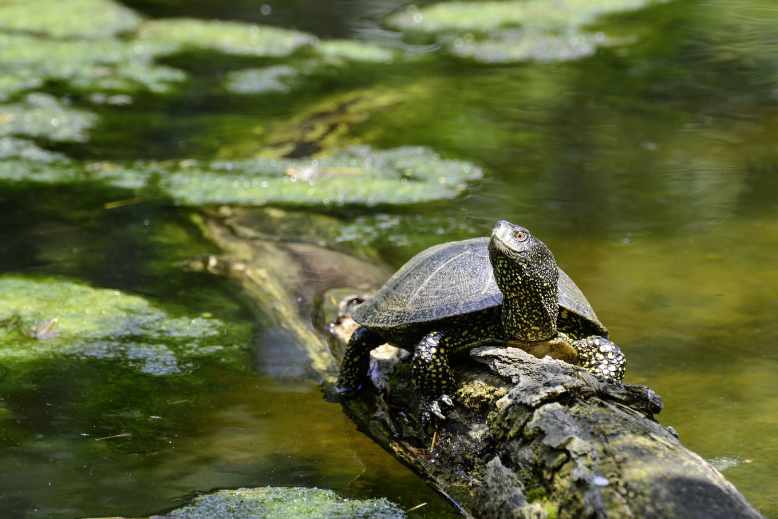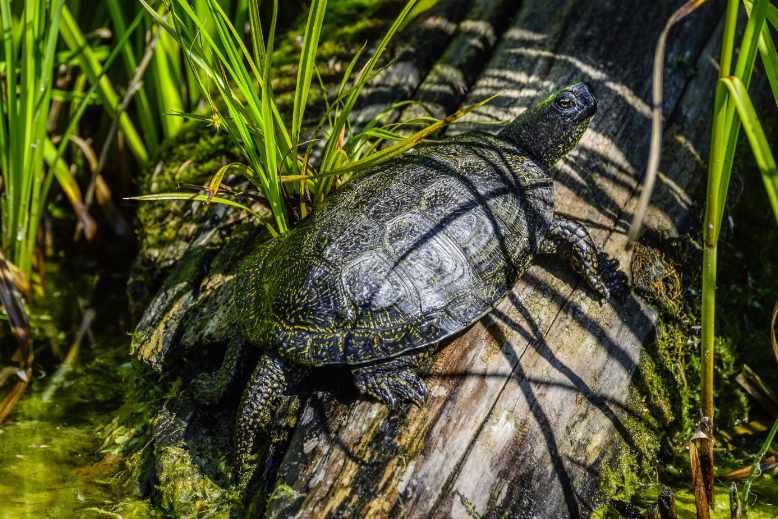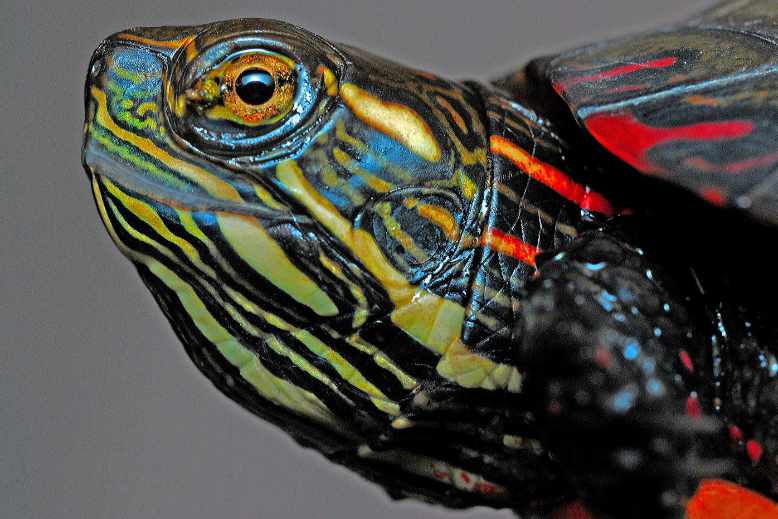Do turtles need a heat lamp? They absolutely do! Turtles being ectothermic creatures, adjust and maintain their body temperature by getting heat from external heat sources such as turtle lamps and sunlight. Without a well-adjusted heating system, these beautiful creatures can lose their appetite, and their immune system becomes weak, making them vulnerable to numerous health concerns.
Turtles are marvellous creatures, and they are relatively easy to take care of. Nonetheless, there are a few things without which these shelled fellows cannot survive for long. One such thing is appropriate temperature and heat. Every turtle requires a heating lamp to survive, but there is no single and suitable heat lamp for every turtle. Some heat lamps offer more heat than others and based on the species of your beloved pet, you may want to opt for a more or less powerful heat lamp.
This article sheds some light on why turtles need a heat lamp and what temperatures are suitable for your turtle species, along with a guide to setting up the perfect heating system for your turtle tank. So without further ado, let’s start reading.

Do turtles need a heat lamp?
Just like food, lighting plays a critical role in the healthy development of these shelled creatures. In their natural habitat, turtles depend on the sun to meet their heat-related requirements.
Nevertheless, getting access to adequate sunlight for captive turtles is a big challenge as reptile owners can’t keep their turtles out in the sun for extended periods. So turtle heat lamps come in handy. They provide our beloved pets with sufficient heat indoors.
Being cold-blooded reptiles, turtles are unable to generate heat on their own. They depend on external sources such as heating lamps to adjust and regulate their body temperature.
Heat lamps provide our turtles with warmth and assist them in their battle against germs. These lamps also ensure that turtles are active and in good physical health.
Incandescent lamps are an excellent choice for heat lamps. Apart from them, halogen lamps also fulfil the necessary heating requirement of our turtles.
Turtle lamp setup precautions
While setting a heat lamp for your turtles, make sure it is in the direction of the basking area. Plus, the lamp should be at the perfect distance from the basking spot. Likewise, reptile owners must set the heat lamp so that the basking spot temperature is at least 12-15 Fahrenheit warmer than the tank’s actual water temperature.
Set the turtle lamp in such a way that the warmest part of the basking spot remains at the high end of the temperature range. On the other side, the coolest part of the basking area should hold the lower end of the temperature. Such settings ensure that your cold-blooded reptile can regulate its body temperature by moving towards the basking area.
If your turtle seems ill, you can raise the temperature for a speedy recovery. It is important to remember that no two turtle species are identical, and thus you need to set the temperature that’s best for your turtle. Nevertheless, heat is the basic requirement of most turtle species, making heat lamps necessary.
Well, now that we know the importance of having a heat lamp and basic precautions, let’s look at the temperature requirements of different turtle species.
The temperature you want for your turtle
A heat lamp is a must for all turtles. Yet no two turtles require the exact temperature. So let’s have a brief look at what temperature we should be aiming for before setting up a heat lamp.
| Turtle Species | Temperature (Fahrenheit) | Temperature (Celsius) |
| Box Turtle | 80 – 90°F | 26 – 32°C |
| Red Eared Slider | 90 – 95°F | 32 – 35°C |
| Baby Box Turtle | 90 – 95°F | 32 – 35°C |
| Young Red Eared Slider | 95 – 100°F | 29 – 37°C |
| Map Turtle | 75 – 80°F | 24 – 26°C |
| Young Map Turtle | 80 – 90°F | 26 – 32°C |
| Musk Turtle | 85 – 90°F | 29 – 32°C |
| Young Musk Turtle | 90 – 100°F | 32 – 37°C |
| Mud Turtle | 90 – 95°F | 32 – 35°C |
| Young Mud Turtle | 90 – 100°F | 32 – 37°C |
| Pond Turtle | 85 – 95°F | 29 – 35°C |
| Young Pond Turtle | 90 – 100°F | 32 – 37°C |
| Cooter | 80 – 85°F | 26 – 29°C |
| Baby Cooter | 90 – 100°F | 32 – 37°C |
| Snapping Turtle | 90 – 95°F | 32 – 35°C |
| Young Snapping Turtle | 95 – 100°F | 29 – 37°C |
Though all species of Turtles require different heating temperatures, some general guidelines are helping you keep your pet comfortable and healthy. The temperature should be somewhere between 85 to 95° Fahrenheit, and water should stay between 75 to 85° Fahrenheit. The nighttime temperature should not drop more than 5 to 10 degrees. Turning the light off at night can also help maintain a proper balance between heat and temperature.

Types of lights you need for a turtle basking area.
To provide your pet with its exact temperature requirements, you need to set up two types of bulbs; one that produces heat and the second one that has UVB light.
- UVB light for turtles
This light spectrum of UV light plays a critical role in the life of most reptiles, including turtles. It helps with the production of vitamin D3, which is vital to maintain the concentration of calcium in the body. Without UVB lights, turtles cannot get the right amount of calcium, leading to softshell metabolic bone disease, improper bone growth shell rot, and many other health conditions.
- Heating light or turtle lamp
The body temperature of these cold-blooded pets mainly relies on the temperature of their environment. In the wild, they use sunlight to warm up, but in captivity, they need heating lamps to imitate the sun in their tanks. Your turtle’s metabolic system slows down without a proper heating system, leading to multiple diseases.
How to set up a heat lamp in your turtle tank
While setting up a heat lamp in your turtle tank, you should pick a spot that’s near the centre of the basking zone. Plus, the heat lamp should be placed at a distance that heats one side of the basking spot to the high end of your turtle’s temperature range. You can set the temperature of the hottest zone of basking area around 85 to 95 degrees Fahrenheit for most adult turtles. For sick or juvenile turtles, the temperature between 90 to 95°F works well.
What you need to do is to create a range of temperature in your basking area so that the turtles can rest in the range they prefer. The hottest spot where the light is pointed should be at the high end of the temperature range of your pet. The coolest part must always stay in the lower end of the temperature range.
By offering a wide range of temperatures, you are giving your pet an acceptable way to regulate his body temperature by going from one spot to another. If you have a smaller basking platform, you may have to opt for a bigger one to offer your pet more room to shift towards the right temperature.

How to measure the temperature of your turtle tank?
Temperature is a really critical aspect of a turtle’s life. Thereby you need to know the exact temperature of the enclosure. As reptile enthusiasts, we won’t suggest anyone guess about basking temperatures. Use a temperature measurer instead to find the right temperature. They are not as expensive as you may have thought and are readily available in your local pet stores. These are essential as if you place your heating lamp too far away, your turtle can feel chilly, leading to respiratory infection, which can be fatal. Place the light too close, and you will end up burning your turtle. So be smart and don’t just guess about the temperature. Use a temperature measurer or a thermometer.
No products found.
While measuring temperatures, we suggest you do not remove your tank covers. Coverings control the intensity of light and heat entering your pet’s habitat, and removing them is likely to give you a false reading.
Do turtles need a heat lamp – Related Questions
- How long do turtles need a turtle lamp?
Turtle lamps are actually a substitute for the heat and light these cold-blooded pets get from the sun.
The sun shines bright 12 hours a day. So that’s when a turtle needs a heat lamp to regulate his body temperature in a closed tank inside the house.
Turtle owners must keep in mind that keeping the heat lamp on for 24 hours is not necessary. Leaving the light on for about 14 to 15 hours every day during the freezing atmosphere works fine.
- Do turtles need a heat lamp at night?
Unless you live in an atmosphere where the temperature drops quickly, turtles don’t require a turtle lamp at night. Nighttime is for resting and sleeping, and thus heat is not necessary to perform the body’s essential functions.
It is excellent if you can replicate your pet’s natural habitat in captivity. For instance, you can turn the heat lamp on when the sun is up and switch it off when it goes down. By doing so, you can simulate the conditions that these reptiles have in their natural environment.
- Do all turtles need a heat lamp?
These ectothermic creatures use the environment to regulate their body temperature. Thus turtle owners must keep their pets in warm enclosures for optimal health.
A heat lamp is a must for all reptiles to keep their body and environmental temperature within a particular range, and turtles have no exception.
Some common turtle species that require a turtle lamp are
- Painted turtles
- Box turtles
- Red-eared sliders
- Musk turtles
- Snapping turtles
- Common musk turtles
- Yellow-bellied turtles
- African side neck turtles
- Wood turtles
- Mud turtles
- Reeves turtles
- Map turtles
- And freshwater turtles
Aquatic turtle species prefer spending most of their time in the water. But sometimes, they emerge from the water to bask; thereby, a basking lamp is essential for their overall development.
Painted turtles also do not require hot temperatures to flourish. However, they are more active and eat well if their tank is heated correctly.

- Are there any turtles who don’t need a heat lamp?
Though most turtles need external heat to maintain their body temperature, some species don’t bask. So they may not require a heating source.
Turtles being the most adaptive pets, adjust well to their environment. Some of their species live comfortably even when the temperature drops down, which means an adult turtle may survive without a turtle lamp. Nonetheless, keeping these cold-blooded pets in low temperatures is not advisable as their health can quickly deteriorate.
- Can turtles live without a heat lamp?
The answer is a big fat no! Turtles cannot survive without a good heating source for long. They need an external source to regulate their body temperatures. The absence of heat for longer durations can cause harm to your turtle’s health.
A healthy pet turtle may survive a week without a heat lamp. But after this period, the reptile is very much likely to get cold and respiratory infections that can prove fatal if not treated immediately.
Low-temperature adjustments also lead to slow metabolisms, making a turtle lose its appetite. It also weakens the immune system, making your pet susceptible to numerous diseases.
- Do turtles need heat lamps in summer as well?
Yes. Turtles need heat lamps all year round. They need a basking temperature of around 100°-105 ° Fahrenheit. A closed enclosure cannot produce this heat even in summer; thus, heat lamps are essential.
Final words
To keep your beloved pet in excellent physical and mental health, you have to set up a proper heating system in the enclosure. Turtles get heat for 10 to 14 hours every day in their natural habitat. So you need to ensure that your captive turtle receives the same amount of heat in his tank. Follow this guide to set up a turtle heater in your turtle tank and create a comfortable environment for the beautiful creature to grow healthy.
Last update on 2023-07-31 / Affiliate links / Images from Amazon Product Advertising API




